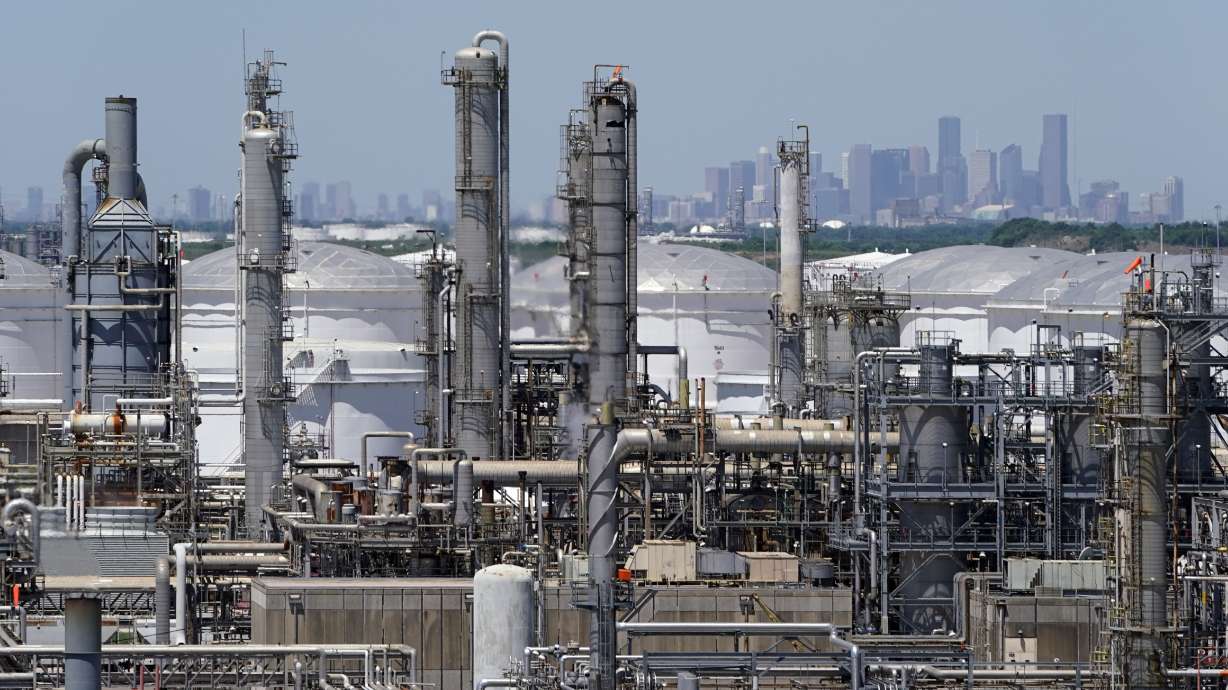Estimated read time: 5-6 minutes
This archived news story is available only for your personal, non-commercial use. Information in the story may be outdated or superseded by additional information. Reading or replaying the story in its archived form does not constitute a republication of the story.
WASHINGTON — Democrats pushed a long-anticipated bill through the Senate this weekend that advocates say is the single largest step towards combating climate change in U.S. history.
The result of nearly two years of negotiations, the 730-page Inflation Reduction Act contains $369 billion for "energy security and climate change," intended to fund clean energy projects, provide tax breaks for electric vehicles, increase domestic manufacturing for renewable energy and reduce pollution.
It passed along party lines with a tie-breaking vote from Vice President Kamala Harris. Republicans blasted the bill, including Utah Sen. Mitt Romney, who called it "yet another reckless taxing-and-spending spree being touted as 'anti-inflation' legislation."
The bill also tackles other Democrat goals like attempting to lower prescription drug prices and increasing taxes on corporations. House votes on the bill are expected Friday.
"I don't know if it's quite caught up with me yet," Sen. Martin Heinrich, D-N.M., told reporters. "We thought we were going to get this done back in 2009, 2010 and obviously it took another 12 years. It's going to be transformative."
From restructuring the century-old leasing system for oil production on public lands, to dumping more money into National Forest management, here's how the sweeping bill will impact the West.
Tax credits to slow global warming
The Inflation Reduction Act is the nation's most significant investment toward reducing demand for fossil fuels and fighting climate change to date.
Most significant is the hundreds of billions in tax credits, available for the next 10 years, to promote electric vehicles and incentivize utilities to take on renewable energy projects. Consumers will get around $7,500 for new electric vehicles and $4,000 for used purchases.
According to the New York Times, by 2030 that measure alone will help the U.S. cut carbon emissions to 40% below 2005 levels. Here's where some of those credits will go:
- Roughly $30 billion towards solar panel, wind turbine, critical mineral and battery production.
- Around $10 billion to build manufacturing facilities for renewable energy and electric vehicles.
- Available through the Defense Production Act, the bill allocates $500 million for heat pumps and critical mineral production.
- Around $9 billion will go towards rebates for home improvements to conserve energy, with an additional $1 billion to make public housing greener.
- The bill establishes a $27 billion clean energy loan fund that, according to Vox, will finance renewable energy and remediation projects in low-income areas.
Changes to oil and gas production
West Virginia Democratic Sen. Joe Manchin stood as one of the bill's biggest roadblocks during the months of negotiations. He ensured a number of concessions related to fossil fuel production before throwing his support behind the bill. They include:
- Requiring at least 60 million acres of offshore leases available each year, including new oil drilling leases in the Gulf of Mexico and Alaska.
- Expanding tax credits for carbon capture technology, allowing coal plants to operate with reduced emissions.
- Making more fossil fuel leases available for every renewable project on federal land approved by the U.S. Department of the Interior.
However, the bill also restructures the federal leasing system, requiring oil and gas companies to pay before they nominate public land for production, which, according to the public land advocacy group Western Priorities, will force companies to pay more royalties.
It also:
- Bumps the minimum bid for an onshore lease from $2 per acre to $10 per acre.
- Repeals a freeze on offshore wind power leases that former President Donald Trump enacted.
- Requires oil and gas companies to pay up to $1,500 in fees for methane leaks.
Managing public land
The Inflation Reduction Act is the latest attempt by Congress to put more money into federal land management, which faces a daunting maintenance backlog and staffing issues. That includes:
- Roughly $1.8 billion for fuel reduction projects on National Forest land in the urban-wildland interface.
- An additional $200 million for vegetation management projects, designed to reduce dangerous fuels and restore forests. About $50 million will also go towards protecting old-growth forests.
- Over $2 billion in grants that, among other forest management projects, will fund "tree planting and related activities." States, local governments and tribes are all eligible.
- Around $1 million in technical assistance for conservation projects through the Natural Resources Conservation Service.
- A push to hire more National Park Service employees, appropriating $500 million through 2030 to bolster staff. The park service will also see $200 million to address its deferred maintenance backlog.
- More funding to the Bureau of Reclamation, which will now have $4 billion available for grants and contracts for drought resilience with an emphasis on the Colorado River Basin, $550 million for water supply projects, and $25 million for canal improvement projects.
- Up to $250 million for conservation and resource protection on National Park Service and Bureau of Land Management land.
Addressing pollution and environmental justice
The bill directs about $60 billion towards environmental justice initiatives. That includes:
- Around $15 billion earmarked for reducing emissions and clean energy projects in low-income communities.
- Community groups, tribal, state and local governments can apply for $3 billion in block grants intended for things like weather resilience, abandoned mine reclamation and air quality monitoring.
- Roughly $2.25 billion to reduce air pollution at ports, which includes installing zero-emission equipment, planning and permitting associated with reducing pollution and developing "qualified climate action plans."










